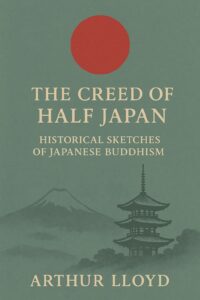
Arthur Lloyd’s The Creed of Half Japan: Historical Sketches of Japanese Buddhism (1911) remains one of the most perceptive early Western accounts of Japan’s religious life. Written by a long-term resident of Japan and professor of philosophy at Tokyo Imperial University, Lloyd’s book captures the complexity of Buddhist belief and practice in a nation balancing ancient traditions with modern change.
The title’s “half Japan” refers to the profound role Buddhism has played in shaping Japanese thought, culture, and aesthetics. Lloyd examines how the various sects—Zen, Shingon, Pure Land, Nichiren, Tendai, and others—arose and evolved, each responding to different human needs and historical moments. He traces the transmission of Buddhist philosophy from India to China and into Japan, showing how it merged with Shinto animism and Confucian ethics to form Japan’s distinctive religious identity.
Beyond its historical scope, The Creed of Half Japan offers a philosophical reflection on the Buddhist way of understanding existence. Lloyd contrasts the contemplative spirituality of Zen with the devotional warmth of Pure Land Buddhism and the fervent social activism of Nichiren. The tone is both scholarly and empathetic—rare for its time—revealing a deep respect for the spiritual insights of the East.
For readers of HolyBooks.com, this work stands as an essential resource on the meeting between East and West. It sheds light not only on Japanese religion but also on the universal search for meaning and liberation that links all traditions. This carefully written study continues to resonate today, more than a century after its publication, as a window into the intellectual and spiritual heritage of Japan. Download the free PDF e-book here:
 The creed of half Japan – historical sketches of Japanese Buddhism
The creed of half Japan – historical sketches of Japanese Buddhism

